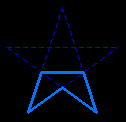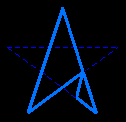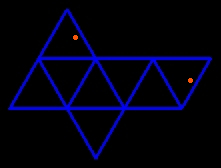Curiosity: by alternating this polyhedron with a regular dodecahedron you can fill the space.

It has tetrahedral symmetry without reflection plan, thus exists in two mirror image versions.

|
compound of two regular triangular prisms
|
regular pentagrammic pyramid
|
regular pentagrammic prism
|
a pentagonal star
|
pentagrammic bipyramid
|
non crossed regular pentagrammic antiprism
|
| This uniform polyhedron, the tetrahemihexahedron, has only seven faces: four triangles and three squares going through the center and two by two orthogonal. Its twelve edges are the sides of the four triangles. It is a one-sided surface therefore non orientable.
This heptahedron is a faceted regular octahedron from which four regular tri-right-angled tetrahedra have been excavated. |
||
|
|
|
| The faces of this dodecahedron are identical non convex symmetrical pentagons (piece of a pentagram). It has tetrahedral symmetry with only three reflection planes two by two orthogonal.
Curiosity: by alternating this polyhedron with a regular dodecahedron you can fill the space.
|
|
| The faces of this dodecahedron described by George Olshevsky are also identical non convex pentagons cut out from an acute golden triangle: a face is the assembling of two obtuse golden triangles (one vertex of the pentagon belongs to the opposite side).
It has tetrahedral symmetry without reflection plan, thus exists in two mirror image versions.
|
|
|
The net of this non convex deltahedron is also a net of the regular octahedron; this means that the two polyhedra have the same faces, but one is convex and the other isn't. The two sides marked with a red point build the edge of the unique "valley fold". |
 |
|
tetrahedral symmetry (6 symmetry planes, 24 faces) |
octahedral symmetry (9 symmetry planes, 48 faces) |
|
7x(2x5) = 70 faces |
3x(2x5) + 3x(2x4) = 54 faces |
|
3 triangles, 3 squares and 3 pentagons |
a toroid with 6 triangles and 6 pentagons |
|
|
|
On both compounds the intersection of the three prisms is a cube; hit "f" to see this hidden cube.
| references: |
• http://cs.stmarys.ca/~dawson/images3.html by Robert Dawson.
• Hedron by Jim McNeill |
home page
 |
convex polyhedra - non convex polyhedra - interesting polyhedra - related subjects | January 2004 updated 08-08-2012 |